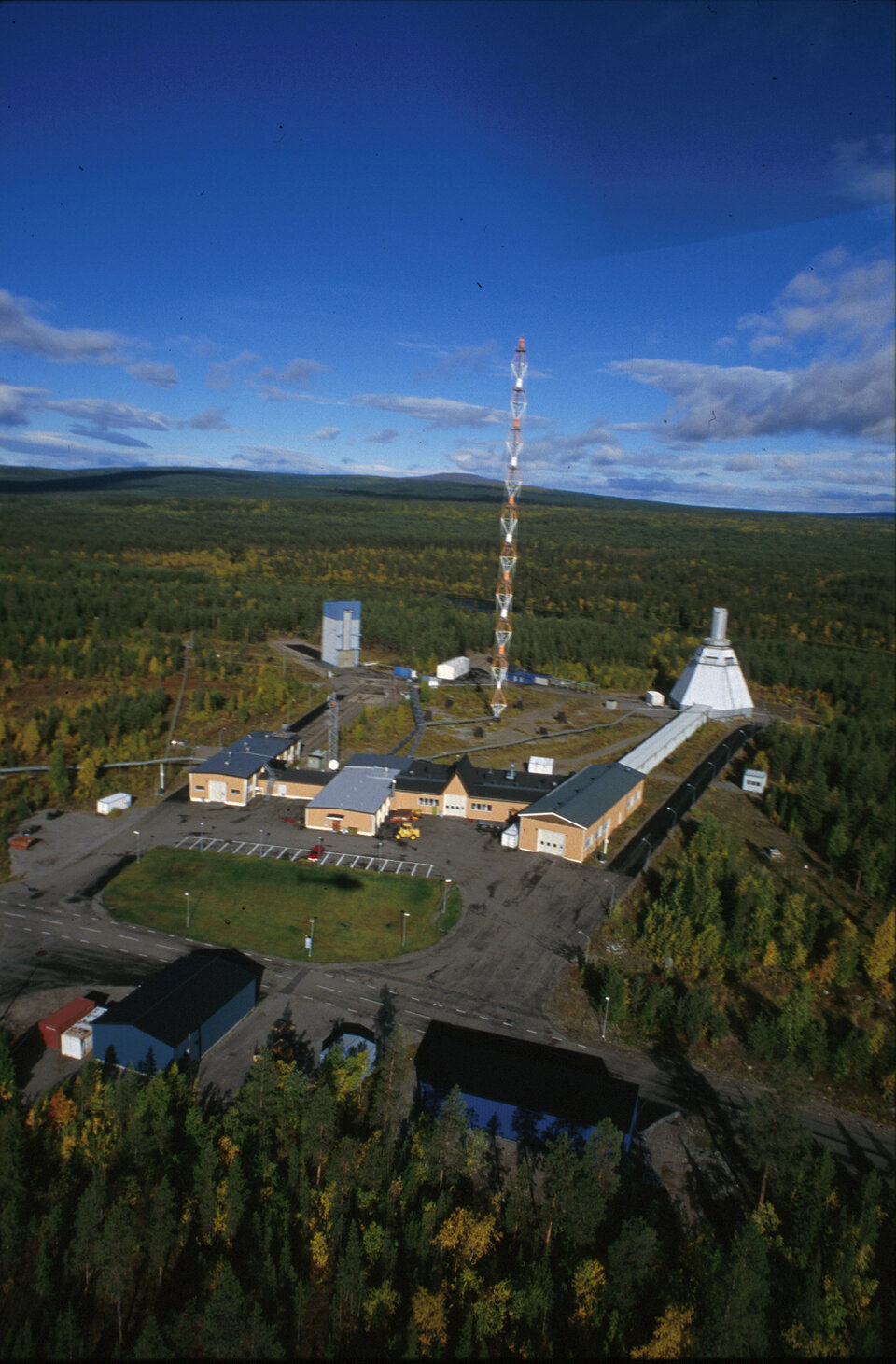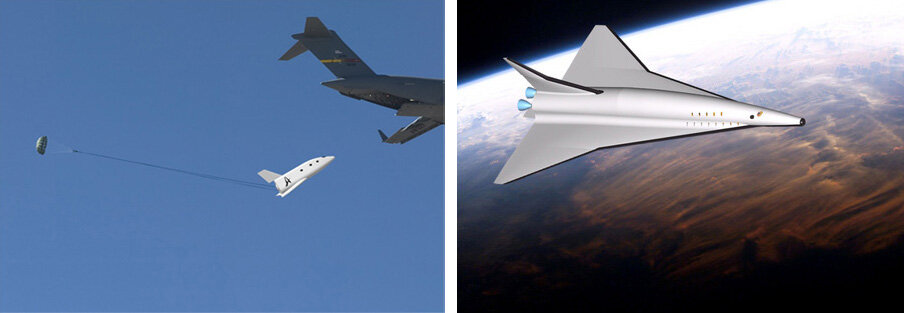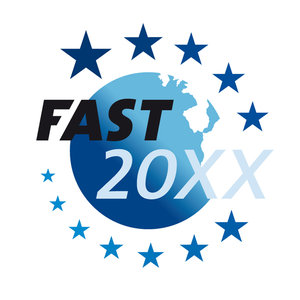FAST20XX (Future High-Altitude High-Speed Transport 20XX)
Will we be able to fly faster during the 21st century than we could by the end of the 20th? The Future High-Altitude High Speed Transport 20XX project aims to establish sound technological foundations for the introduction of advanced concepts in suborbital high-speed transportation.
The project - FAST20XX for short - is part of the European Commission’s Seventh Framework Programme and run on behalf of the Commission by ESA. It involves a focus on two novel concepts envisaged as taking place on two separate timelines, in order to identify and master the most critical research and technology development (RTD) stages associated with achieving them. In parallel, non-technical building blocks such as certification are also being addressed.
The first concept, ALPHA, is a vehicle that is air-launched from a carrier plane before igniting a hybrid rocket motor to climb out of the atmosphere, then finally gliding back to Earth, like well-known X-Prize winner SpaceShipOne. This concept is envisaged in the medium term of five to ten years.

The second concept, SpaceLiner, is an all-rocket powered design which would transport about 50 people across long distances in an extremely short time. This fully-reusable two-stage concept would take off vertically and land horizontally. This concept is seen as taking place in the longer term, meaning the second part of the century.
During the transportation phase both concepts would allow people to have a view of Earth and space at the same time. Particular attention is being paid to how such concepts can be put into operational use, and the benefit for society is being addressed.
Preparing the way
Certain prerequisites are essential for the commercial operation of high-altitude, high-speed transport. High on the list is a tolerant regulatory framework. The US Federal Aviation Authority (FAA) has issued relaxed requirements for operators marketing commercial suborbital flights, enabling the corresponding market to exist and develop. These regulations are initially valid until about 2012.
Left: ALPHA, hybrid propelled vehicle launched at high altitude for short-range flights (here: one of several launch options).
Right: SpaceLiner, two-stage all rocket propelled vehicle launched vertically from ground for ultra-fast long-range flights.
In Europe practical and successful attempts to fly experimental vehicles of this kind do not yet exist, particularly with paying passengers on board. However the time is coming closer: in 2007 Astrium Space Transportation proposed a horizontally launched and landed vehicle with mixed jet engine and rocket propulsion while Sweden’s Esrange launch facility, best known for launching sounding rockets and stratospheric balloons, has concluded a partnership agreement with future suborbital flight operator Virgin Galactic that will see it become their initial European spaceport.

It will be important for future developments to tackle legal efforts and reduce the certification efforts common to commercial transportation in a meaningful way. This includes the identification of requirements which corresponding airports have to satisfy. Liability and insurance issues need to be considered as well.
And if offering high-altitude human flights is really going to become a commercial attractive and enduring activity, potential passengers will need to have a bearable and enjoyable experience to look forward to. This means that existing medical research will have to be revisited in terms of the ordinary passenger rather than specially-trained astronauts, investigating the maximum acceleration loads that such passengers can undergo without feeling uncomfortable.
Last but not least an abort capability is required, in particular for the non-air launched concepts, to satisfy the highest possible safety requirements – safety being the single most important item to be respected.
Technical challenges
The FAST20XX project is addressing specific technical challenges inherent in the two concepts under study. These include:
- Hybrid propulsion - This propulsion type combines the simplicity of solid fuel propulsion with the fail-safe operation, throttle ability and shutdown capability of liquid fuel propulsion. Hybrid propulsion is generally considered safe, as shown by Burt Rutan’s SpaceShipOne in the USA, although the possibility of accidents cannot be excluded – in 2007 a fatal explosion took place in the frame of the SpaceShipTwo development process. Europe has limited experience with the use of hybrid propulsion technology, especially associated with human transport.
- Innovative, high performance cooling techniques – The extreme temperatures experienced in the nose and leading-edge regions of ultra-fast concepts require advanced active cooling. Novel and potentially reusable cooling systems will be needed which should be robust while also lightweight in nature. Some promising techniques have been identified – such as fluid transpiration through porous material – for which the associated level of technological readiness will need to be significantly raised. In addition, the limits of selected ceramic heat protection systems will be probed to determine the range at which active cooling concepts are definitely required.

- Separation techniques – Europe has extensive practical experience with unmanned booster-rocket separation due to Ariane. This is not the case for the separation of winged vehicles, especially with passengers onboard. Separation mechanisms and aerodynamics will require in-depth investigations and testing to enable safe transportation. Corresponding experiments are difficult to carry out, often destructive and expensive, and therefore restricted to guided and quasi-separation processes. The computational technology for free separation simulation will be developed for the air-launch concept.
- Flow control – Global know-how on maintaining the stable or ‘laminar’ flow of around the surface of supersonic or hypersonic vehicles remains limited. However the ability to stabilise such flows and to extend the length of the laminar flow region relative to the ‘turbulent flow’ found behind it is of critical importance in hypersonic vehicle design. Early transition from one to the other causes significant increases in heat transfer and skin friction. These higher heating rates require a heavier thermal protection system (TPS), translating into higher cost and weight of the hypersonic vehicle. The vehicle has a low payload to mass fraction, so even small savings in TPS weight can provide a significant payload increase.
- Guidance and navigation control (GNC) techniques – How might the latest results from control theory best be applied to the highly demanding area of atmospheric reentry? The main challenge comes from the inherent uncertainty in the performance parameters of manoeuvrable reentry vehicles, which require the application of robust, advanced flight mechanics methods for modelling, designing control systems and the process of certification. A multidisciplinary approach is required to tackle the multivariable non-linear time-varying and uncertain nature of vehicle dynamics through the various steps of the GNC process, from modelling through GNC design and analysis, verification and validation, until the final certification of GNC functionality.
- Safety analysis – For human flight in general, and new forms of it in particular, it is vital to minimise risk since a fatal accident at the very beginning of commercially conducted flights will risk the extinguishment or, at the very least, delay of any further business. Therefore considering and identifying safety requirements with respect to passengers, the on-ground population, air traffic management, airlines and human factors will be crucial for the successful marketing of suborbital human transportation.
Evolving concepts
The vehicle concepts outlined above will define the conditions and constraints for each of these technologies. Their outcome will be incorporated into these concepts as they become available, driving the evolution of their design and assuring the integration of the latest technological findings.
FAST20XX has different but at the same time complementary objectives to the EC’s LAPCAT II and ATLLAS projects. Whereas the former focuses on advanced propulsion concepts and the latter on high-speed lightweight materials, both are geared towards use in high-speed atmospheric transportation over long distances. Since all three projects are being coordinated at ESA’s ESTEC facility in Noordwijk in the Netherlands, achieving synergies between the three projects is guaranteed.






